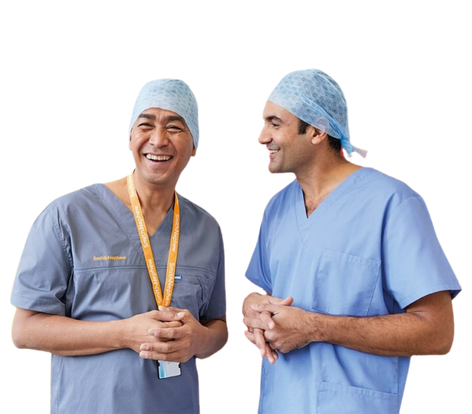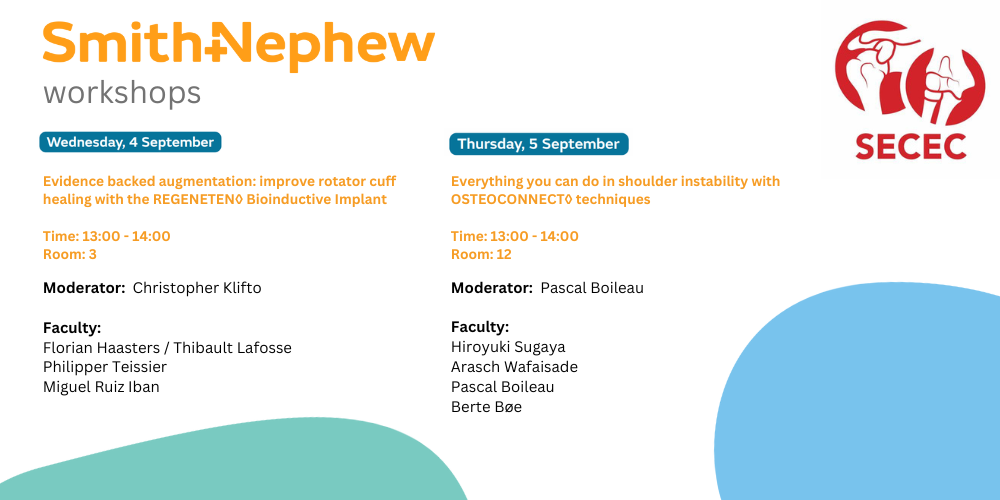













The 31st SECEC/ESSSE Congress takes place in Munich on 4-6 September 2024 and it’s the annual congress of the European Society of Shoulder and Elbow Surgery. It’s one of the most important appointments for shoulder surgeons around Europe and around the Globe.
Visit our booth and don't forget to register to receive the latest evidence!

Smith & Nephew is glad to support the 31st SECEC 2024 congress and to promote our most advanced technologies which redefine shoulder repair: ADVANCED HEALING PORTFOLIO which includes REGENETEN, HEALICOIL Family of anchors and REGENESORB, and the INSTABILITY EXCELLENCE portfolio which includes OSTEOCONNECT techniques and the recently launched Q-FIX with MINITAPE.
During the congress Smith & Nephew will showcase our latest technologies at the booth and during 2 workshops which are focused on the ADVANCED HEALING portfolio and on the OSTEOCONNECT techniques.

The REGENETEN Bioinductive Implant supports the body’s natural healing response to promote new tendon-like tissue growth and change the course of tear progression.1, 2, 9–11 Derived from highly purified bovine Achilles tendon, it creates an environment that is conducive to healing.1, 2, 9, 27
The unique open-architecture design of HEALICOIL anchors reduces the amount of implanted material in the shoulder compared to traditional, solid-core anchors.28
Effective absorption and bone replacement in 24 months.6–8* REGENESORB material is designed to provide a jump start in bone healing and formation.
Elevate your expertise for shoulder instability repairs. With solutions ranging from simple to complex, Smith+Nephew’s Instability Excellence portfolio is setting new standards to take you to the next level while returning your patients to peak performance.
No matter the repair, the procedure or the pathology, Smith+Nephew’s Instability Excellence portfolio has you covered.
Regardless of the complexity, you’ll find solutions around the entirety of the glenoid including; soft tissue repairs and complex instability repairs. Explore our portfolio below.
1. Bokor DJ, Sonnabend D, Deady L, et al. Evidence of healing of partial-thickness rotator cu tears following arthroscopic augmentation with a collagen implant: a 2-year MRI follow-up. Muscles, Ligaments Tendons J 2016;6(1):16-25.
2. Schlegel TF, Abrams JS, Bushnell BD, Brock JL, Ho CP. Radiologic and clinical evaluation of a bioabsorbable collagen implant to treat partial-thickness tears: a prospective multicenter study. J Shoulder Elbow Surg. 2018 27(2):242-251.
3. Bokor DJ, Sonnabend D, Deady L, et al. Preliminary investigation of a biological augmentation of rotator cu repairs using a collagen implant: a 2-year MRI follow-up. Muscles, Ligaments Tendons J 2015;5(3):144-150.
4. Chahla J, Liu JN, Manderle B, et al. Bony Ingrowth of Coil-Type Open-Architecture Anchors Compared With Screw-Type PEEK Anchors for the Medial Row in Rotator Cu Repair: A Randomized Controlled Trial. Arthroscopy. 2020;36(4):952-961.
5. Clark TR, Guerrero EM, Song A, O’Brien MJ, Savoie FH. Do vented suture anchors make a dierence in rotator cu healing. Ann Sports Med Res. 2016;3:1068.
6. Vonhoegen J, John D, Hägermann C. Osteoconductive resorption characteristics of a novel biocomposite suture anchor material in rotator cuff repair. Orthop Traumatol Surg Res. 2019;14(1):12.
7. Smith+Nephew 2010. Micro-CT and histological evaluation of specimens from resorbable screw study (RS-II / OM1-08) 24-month post-implantation. Internal Report WRP-TE045-700-08.
8. Smith+Nephew 2016. HEALICOIL REGENESORB Suture Anchor – a study to assess implant replacement by bone over a 2 year period. NCS248.
9. Van Kampen C, Arnockzky S, Parks P et al. Tissue-engineered augmentation of a rotator cuff tendon using a reconstituted collagen scaffold: A histological evaluation in sheep. MLTJ. 2013;3:229-235.
10. Bokor DJ, Sonnabend DH, Deady L, et al. Healing of partial-thickness rotator cuff tears following arthroscopic augmentation with a highly porous collagen implant: a 5-year clinical and MRI follow-up. Muscles, Ligaments Tendons J. 2019;9(3):338-347.
11. McElvany MD, McGoldrick E, Gee AO, Neradilek MB, Matsen FA, 3rd. Rotator cuff repair: published evidence on factors associated with repair integrity and clinical outcome. Am J Sports Med. 2015;43(2):491-500.
12. Material and Structural Testing Core, Mayo Clinic 2019. Proof-of-concept Finite Element Modelling of Effect of Tissue Induction on Rotator Cuff Tears. Internal Report. EO/SPM/REGENTEN/001/V1.
13. Arnoczky SP, Bishai SK, Schofield B, et al. Histologic Evaluation of Biopsy Specimens Obtained After Rotator Cuff Repair Augmented With a Highly Porous Collagen Implant. Arthroscopy. 2017;33(2):278-283.
14. Smith+Nephew 2020. HEALICOIL KNOTLESS claims testing, less suture displacement after postoperative cyclic loading 15009719 A.
15. Smith+Nephew 2020. HEALICOIL KNOTLESS claims testing, proven internal locking plug mechanism 15009718 A.
16. Smith+Nephew 2020. HEALICOIL KNOTLESS claims testing, less foreign material than competitor 15009720 A.
17. Kim JH, Kim YS, Park I, Lee HJ, Han SY, Jung S, SHin SJ. A Comparison of Open-Construct PEEK Suture Anchor and Non-Vented Biocomposite Suture Anchor in Arthroscopic Rotator Cuff Repair: A Prospective Randomized Clincial Trial. Arthroscopy. 2020, 36 (2): 389-396.
18. Constantino, Friedman. Synthetic Bone Graft Subsitutes. Otolaryngol Clin North Am. 1994 27(5):1037-1074.
19. Walsh WR, Morberg P, Yu Y, et al. Response of a calcium sulfate bone graft substitute in a confined cancellous defect. Clin Orthop Relat Res. 2003(406):228-236.
20. Calori GM, Mazza E, Colombo M, Ripamonti C. The use of bone-graft substitutes in large bone defects: Any specific needs? Injury. 2011;42(2):S56-S63.
21. Arai E, Nakashima H, Tsukushi S, et al. Regenerating the fibula with beta-tricalcium phosphate minimizes morbidity after fibula resection. Clin Orthop Relat Res. 2005(431):233-237.
22. Gaasbeek RD, Toonen HG, van Heerwaarden RJ, Buma P. Mechanism of bone incorporation of beta-TCP bone substitute in open wedge tibial osteotomy in patients. Biomaterials. 2005;26(33):6713-6719.
23. Park K, Skidmore S, Hadar J, et al. Injectable, long-acting PLGA formulations: Analyzing PLGA and understanding microparticle formation. J Control Release. 2019;304:125-134.
24. Chu C-C. Section IV:44, Biodegradable Polymeric Biomaterials: An Updated Overview. In: The Biomedical Engineering Handbook. Bronzino JD Ed. CRC Press.; 1995.
25. Smith+Nephew 2019 Verification, Microraptor Knotless Real Time Degredation. Revision B. Internal Report 15007134.
26. Smith and Nephew 2019. Verification, Microraptor Knotless Accelerated Degredation. Internal Report 15007045.
27. Smith + Nephew 2020 REGENETEN Collagen Implant Physical Characteristics. Internal Report
28. Smith+Nephew 2021. Technical Report, HEALICOIL Implant Volume Comparison. Internal Report. 15010823 Rev A
29. Allison DC, Lindberg AW, Mirzayan R, Samimi B, Menendez LR. A Comparison of Mineral Bone Graft Substitutes for Bone Defects. US Oncology and Hematolog. 2011.
30. Ogose A, Kondo N, Umezu H, et al. Histological assessment in grafts of highly purified beta-tricalcium phosphate (OSferions) in human bones.
* Demonstrated clinically and in vivo